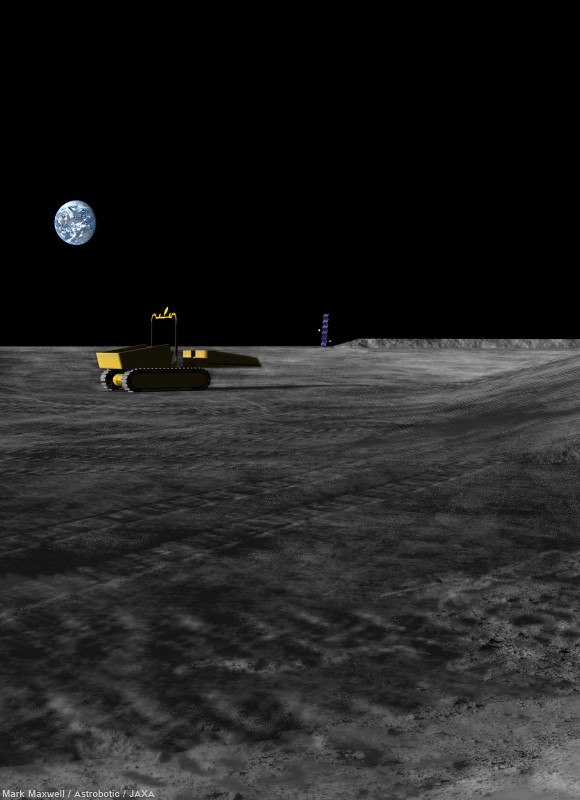 |
| Astrobotic (CM) Moon Digger concept [Mark Maxwell/Astrobotic/JAXA]. |
Urbano Fuentes
The Space Review
In 1969, the United States successfully performed the first human landing on the surface of the Moon. Neil Armstrong and Buzz Aldrin placed an American flag in the lunar surface, winning the space race against the Soviet Union. The US government stated later that no sovereignty claims of any kind were made on the Moon. After that historical breakthrough and for decades to come, space exploration suffered a considerable slowdown. The United States had won the space race, and no serious efforts have since been made by any nation to return to the Moon.
In 1985, researchers at the University of Wisconsin discovered that the lunar soil had a considerable amount of the rare isotope of helium known as helium-3 (He-3). This scarce element could be used in energy production, in fusion power plants that—hypothetically—could produce an amount equivalent to 130,000,000 barrels of oil per ton of He-3.1 . It is also environmentally friendly, producing no greenhouse gases or radiation.
Whether because of helium-3 or not, several nations have recently shown interest in returning to the Moon. In 2013, China became the third country to land a spacecraft on the Moon, and other nations have places for lunar missions in the next several years. Besides nations, several private corporations had expressed interest in lunar missions of one kind or another.
Law in this area is not particularly broad. Nevertheless, during the Cold War and because of the progress in the field of space exploration in those early years, some international treaties related to the legal status of the Moon and the outer space region arose, creating a legal regime that is still valid today. Those treaties are the Outer Space Treaty (1967) and the Moon Treaty (1979), currently the existing legal framework valid to some extent.
These treaties, while overlapping to some degree, settled a series of principles regarding human activities outside Earth. The Outer Space Treaty forbids the placement of weapons of mass destruction in space; it also addressed the situation of lunar sovereignty, claiming that the celestial bodies could not be subject of national appropriation. The later Moon Treaty established that the Moon shall be regarded as common heritage of mankind, in a similar regime as the one applicable to the Deep Sea Bed Area.
This essay will address primarily the legal status of the Moon, using the existing framework on the subject. Taking into account the current state of space exploration and other legal systems similar to the one of the Moon, such as the Deep Sea Bed Area, it will analyse the question of whether the Moon could be considered the Common Heritage of Mankind, or if some other legal concept should be used in relation to its resources.
Read the full essay in The Space Review, HERE.

3 comments:
the moon is a shining star that i love
http://awttan.blogspot.com/
http://lebnaneyat.blogspot.com/
http://firstlyrics.blogspot.com/
http://ebookscycle.com/
http://gratisprogrammadownloaden.blogspot.com/
http://downloadprogrammkostenlos.blogspot.com/
http://telechargerprogrammegratuit.blogspot.com/
http://pdf-ebooks-free.blogspot.com/
http://e-bookscycle.blogspot.com/
http://ebookscycle.blogspot.com/
http://downloadfreefullprograms.blogspot.com/
http://downloadfree-programs.blogspot.com/
http://serialscrackskeygen.blogspot.com/
how to write such beautiful words
http://awttan.blogspot.com/
http://lebnaneyat.blogspot.com/
http://firstlyrics.blogspot.com/
http://ebookscycle.com/
http://gratisprogrammadownloaden.blogspot.com/
http://downloadprogrammkostenlos.blogspot.com/
http://telechargerprogrammegratuit.blogspot.com/
http://pdf-ebooks-free.blogspot.com/
http://e-bookscycle.blogspot.com/
http://ebookscycle.blogspot.com/
http://downloadfreefullprograms.blogspot.com/
http://downloadfree-programs.blogspot.com/
http://serialscrackskeygen.blogspot.com/
قناة الحياة بث مباشر
قناة mbc مصر بث مباشر
قناة النهار بث مباشر
قناة النهار دراما بث مباشر
Post a Comment